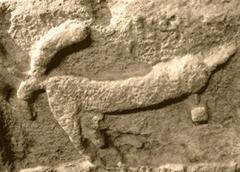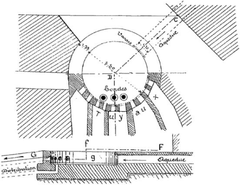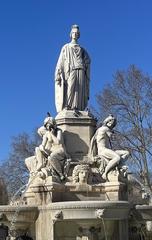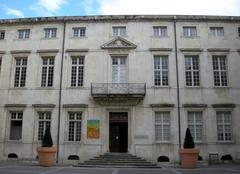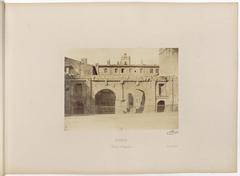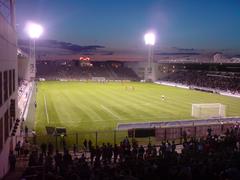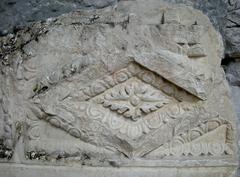Roman City Wall Nîmes: Visiting Hours, Tickets, and Historical Sites Guide
Date: 04/07/2025
Introduction
The Roman City Wall of Nîmes—known locally as the “Muraille Romaine”—is a striking legacy of ancient Roman ingenuity and a defining element of the city’s historical landscape. Erected in the late 1st century BCE under Emperor Augustus, the wall originally enclosed the Roman colony of Nemausus (modern Nîmes) with more than 7 kilometers of imposing limestone fortifications, reinforced by over 80 defensive towers and monumental gateways such as the Porte d’Auguste and Porte de France. These structures not only protected the city but also symbolized Roman power and authority in southern Gaul, shaping the urban experience and economic life of Nîmes.
Today, significant remnants of the wall—including the iconic Tour Magne—offer visitors an unparalleled opportunity to step back into Roman times. This comprehensive guide covers the history, architecture, cultural significance, visiting hours, ticketing information, accessibility, and practical travel tips for discovering the Roman City Wall of Nîmes and its surrounding historical sites.
For further reading and official information, consult resources such as France-Voyage, France.fr, and Go Languedoc.
Contents
- Historical Overview
- Origins and Construction
- Architectural Features and Defensive Elements
- Historical Role and Urban Development
- Surviving Sections and Notable Remnants
- Archaeological Discoveries and Preservation Efforts
- Cultural and Symbolic Significance
- Visitor Information
- Visiting Hours
- Tickets
- Accessibility
- Guided Tours
- Travel Tips and Nearby Attractions
- FAQ
- Conclusion
- Recommended Sources
Historical Overview
Origins and Construction
The Roman City Wall of Nîmes was built during the reign of Augustus in the late 1st century BCE, transforming the former Celtic settlement of Nemausus into a model Roman colony. The wall, stretching approximately 7 kilometers and enclosing about 220 hectares, was constructed with massive limestone blocks and punctuated by more than 80 towers and several grand gates (France-Voyage; The Luberon). These fortifications were designed both for defense and as statements of Roman architectural and political dominance (France.fr).
Architectural Features and Defensive Elements
The wall’s structure varied in thickness—typically 2 to 3 meters—and could reach up to 9 meters in height. Defensive towers were spaced at regular intervals to provide surveillance and support. Monumental gates, such as the Porte d’Auguste and Porte de France, featured multiple arches for vehicles and pedestrians and were decorated with reliefs and inscriptions (Brainy Backpackers; France Today).
Historical Role and Urban Development
Beyond military defense, the wall marked the city’s boundaries, facilitated the regulation of trade, and reinforced Nîmes’ status as a provincial capital. It protected the city during periods of unrest—including the decline of the Western Roman Empire—and shaped the development of Nîmes’ urban layout (The Flashpacker).
Surviving Sections and Notable Remnants
Key surviving elements include:
- Tour Magne: The tallest and best-preserved tower, standing atop Mont Cavalier in the Jardins de la Fontaine, offering panoramic views of the city (Go Languedoc; Waves and Cobblestones).
- Porte d’Auguste: The main northern gate, part of the Via Domitia, notable for its multiple arches and decorative stonework (France Adventurer).
- Porte de France: The southwestern gate, recognized for its single arch and evidence of Roman engineering (France Adventurer).
- Wall Fragments: Additional sections can be found near the Boulevard Amiral Courbet and the Jardins de la Fontaine, often integrated into later structures (France This Way).
Archaeological Discoveries and Preservation
Ongoing archaeological work has yielded insights into construction techniques and the evolution of the city’s defenses. Conservation efforts focus on stabilizing ancient masonry, preventing further deterioration, and enhancing public access (France Today).
Cultural and Symbolic Significance
The wall embodies Nîmes’ Roman heritage. It is celebrated through festivals such as the Roman Days of Nîmes, which feature historical reenactments and educational programs (Visit Europe; National Geographic).
Visitor Information
Visiting Hours
- Tour Magne: Open daily from 9:30 AM to 6:00 PM, with possible extended hours in summer. Hours may vary seasonally; always check the official Nîmes tourism website before visiting.
- Porte d’Auguste and Porte de France: These gates are located in public spaces and can be viewed at any time throughout the year.
Tickets
- Tour Magne: Tickets cost approximately €5 for adults, with discounts for students and seniors. Children under 12 are usually admitted free. Combined tickets (Pass Romanité) are available, granting entry to the Arena, Maison Carrée, Tour Magne, and Musée de la Romanité (Waves and Cobblestones).
- Gates and Wall Fragments: Free access.
Tickets can be purchased online, at the Tour Magne, or at city tourist offices.
Accessibility
- Tour Magne: Access involves a narrow spiral staircase and may not be suitable for visitors with mobility challenges.
- Gates and Wall Fragments: Generally accessible on flat terrain. For detailed accessibility information, contact the Nîmes tourist office in advance.
Guided Tours
Guided and audio tours are available in multiple languages, providing in-depth historical context and helping visitors appreciate the architectural and cultural significance of the wall (Diego en France).
Travel Tips and Nearby Attractions
- Nearby Roman Monuments: The Arena of Nîmes (amphitheatre), Maison Carrée temple, and the Temple of Diana in the Jardins de la Fontaine are all within walking distance (France This Way).
- Museums: The Musée de la Romanité features immersive exhibits and artifacts related to the wall and Nîmes’ Roman past.
- Best Time to Visit: Spring and autumn offer comfortable weather for walking and sightseeing. Summer can be hot; bring water and sun protection (The Good Life France).
- Festivals: Experience the city’s Roman heritage during annual events like Les Grands Jeux Romains and the Festival de Nîmes (Europe Bookings).
Frequently Asked Questions (FAQ)
Q: What are the opening hours for the Roman City Wall and Tour Magne?
A: Tour Magne is open from 9:30 AM to 6:00 PM, with potential seasonal changes. Gates and wall fragments are accessible at any time.
Q: How much do tickets cost?
A: Tour Magne: approx. €5 for adults; discounts available. Pass Romanité offers combined admission to major Roman sites.
Q: Are the sites accessible for visitors with disabilities?
A: Gates and wall fragments are generally accessible; Tour Magne involves stairs and is not recommended for those with reduced mobility.
Q: Are guided tours available?
A: Yes, guided and audio tours can be booked through local operators and the tourist office.
Q: What else can I visit nearby?
A: The Arena, Maison Carrée, Temple of Diana, and the Jardins de la Fontaine are all nearby. The Pont du Gard aqueduct is an excellent day trip.
Conclusion
The Roman City Wall of Nîmes stands as an enduring symbol of the city’s ancient heritage and Roman legacy. Its surviving towers, gates, and wall sections invite visitors to explore the architectural grandeur, strategic significance, and cultural vitality of this former Roman stronghold. Modern Nîmes celebrates and preserves this legacy through ongoing conservation, immersive museums, guided tours, and lively festivals.
To make the most of your visit, plan ahead by checking current hours and ticket options, use the Pass Romanité for combined entry, and take advantage of both self-guided and expert-led tours. Don’t miss nearby Roman monuments and the vibrant atmosphere of Nîmes’ historic center.
For updated information and further inspiration, consult official tourism sources and travel guides (France Today; National Geographic; Go Languedoc).
Recommended Sources
- France-Voyage
- France.fr
- The Luberon
- The Flashpacker
- Go Languedoc
- France This Way
- France Adventurer
- Waves and Cobblestones
- France Today
- National Geographic
For enhanced exploration, download the Audiala app for audio-guided tours and interactive maps. Follow us on social media for the latest events and travel tips about Nîmes’ Roman heritage. Add high-quality images of the Tour Magne, Porte d’Auguste, and wall fragments, with descriptive alt tags for accessibility and SEO.
